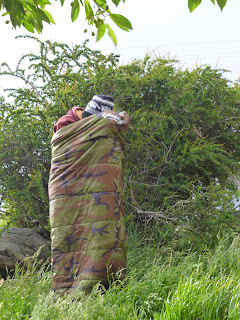In the 1970's General Augusto Pinochet ordered the construction of the road to link many small rural villages and strengthen the Chilean presence in Patagonia -10,000 soldiers were put to the task. The road was to carve a line through Andes mountains, glacial lakes, wetlands and parts of the country that spend half the year under snow. Thirty years, $300m and several lost lives later, the road was mostly finished (although work still continues in some areas). It serves a mere 100,000 people.
It does, however, link some stunningly beautiful areas of Patagonia. Words like "Hanging glaciers", "high-altitude lakes" and "marble caves" were mentioned. It was impossible to resist.
Myself and Simon crossed over the border to Chile and headed to the village of Futaleufu. In a region with high prices and beautiful countryside, pitching a tent is the way to go. Unfortunately, Futaleufu has a population of about 1,000 and most of them hibernate until mid-December so the camping shop was closed. The revised plan was a trip to the local hardware store. A seriously dated two man tent was purchased.
I also acquired what is possibly the thinnest sleeping bag ever made. On the plus side, it is camouflaged - if we get in a firefight with enemy snipers I will probably live longer than Simon.
None of this mattered though because the last time I saw a cloud was in Guatemala. About three seconds after I mentioned that fact it started raining. This side of Patagonia is notorious for wet weather - moisture comes in from the sea and gets pushed up over the mountains, resulting in an average rainfall of 4,000mm for the region.
Even so, we got the tent up and got a fire going to cook up some chorizo - we don't have any cooking implements yet, so had to improvise.
We went for a hike up to Piedra Aguilla (Eagle Rock). There are spectacular views down into the valley as the river snakes its way through the mountains. There is also a nice little lagoon perched high up on a hill.
The following day we bussed it to Santa Lucia. We had a four hour wait for the next bus South so we got back on the road to hitchhike instead. In all that time we only saw three cars, and they were going to a construction site around the corner. Another hitchhiking failure.
Four hours later we got on the bus to La Junta, on the way to our actual destination of Puyuhuapi. There are only two buses a week between the two villages and it was too late to hitchhike so we stayed a night in La Junta and got the bus the next day. We headed straight out to Parque Nacional Quelat to see the hanging glacier. The park is 20km from the village so more hitchhiking was in order. Finally, our luck was in and we got a ride most of the way! Wooohooo!
There is one camping ground in Puyuhuapi - every tent space has a roof over it. Is this really camping?
This was the view from the campground though, so we were happy enough.
When entering Quelat National park you are greeted with a spectacular picture. It gets better the further you go.
This bridge is constructed of the heaviest wood in the world. It is not surprising that the max load is only four people.

















Illuminating and hilarious. The way you guys travel is definitely not for the faint hearted. Great update, thanks!
ReplyDelete